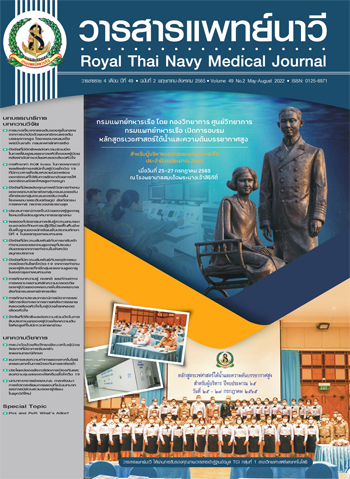The Study of ROX Index to Predict Clinical Outcomes in COVID-19 Patients with Hypoxemic Respiratory Failure Treated with High Flow Nasal Cannula
Main Article Content
Abstract
This retrospective cross-sectional observational study aimed to determine the ROX index to predict clinical outcomes (success and failure) after receiving HFNC treatment at 2, 6, 12, and 24 hours. We collected data using medical records of 113 COVID-19 patients with acute hypoxemic respiratory failure who received HFNC treatment and were admitted in Somdech Phra Pinklao hospital between 1st February 2021 to 31st July 2021. Data were analyzed using descriptive statistic, receiver operating characteristic (ROC), and Areas under the ROC curve (AUROC). The result showed that 51.3% of sample improved oxygenation and were successfully withdrawn from HFNC. The ROX index at 6, 12, and 24 hours of HFNC initiation were closely related to the prognosis. The ROX index after 6h of HFNC initiation (AUROC, 0.549) had correlated with HFNC failure. The healthcare provider can use this as a guideline for HFNC therapy termination in patients with COVID-19 infection related acute hypoxic respiratory failure.
Article Details

This work is licensed under a Creative Commons Attribution-NonCommercial-NoDerivatives 4.0 International License.
References
World Health Organization. Weekly epidemiological update on COVID-19 - 17 April 2022. [Internet]. [cited 2022 May 8]. Available from: https://www.who.int/publications/m/item/weekly-epidemiological-update-on-covid-19---17-april-2022.
Judson SD, Munster VJ. Nosocomial transmission of emerging viruses via aerosol-generating medical procedures. Viruses 2019;11(10):940.
Zhu N, Zhang D, Wang W, Li X, Yang B, Song J, et al. A novel coronavirus from patients with pneumonia in China, 2019. N Engl J Med 2020;382(8):727-33.
Yang X, Yu Y, Xu J, Shu H, Xia J, Liu H, et al. Clinical course and outcomes of critically ill patients with SARS-CoV-2 pneumonia in Wuhan, China: a single-centered, retrospective, observational study. Lancet Respir Med 2020;8(5):475-81.
Rochwerg B, Granton D, Wang DX, Helviz Y, Einav S, Frat JP, et al. High flow nasal cannula compared with conventional oxygen therapy for acute hypoxemic respiratory failure: a systematic review and meta-analysis. Intensive Care Med 2019;45(5):563-72.
Frat J-P, Thille AW, Mercat A, Girault C, Ragot S, Perbet S, et al. High-flow oxygen through nasal cannula in acute hypoxemic respiratory failure. N Engl J Med 2015;372(23):2185-96.
Hansen CK, Stempek S, Liesching T, Lei Y, Dargin J. Characteristics and outcomes of patients receiving high flow nasal cannula therapy prior to mechanical ventilation in COVID-19 respiratory failure: a prospective observational study. Int J Crit Illn Inj Sci 2021;11(2):56-60.
National Institutes of Health. COVID-19 treatment guidelines. [Internet]. [cited 2021 December 17]. Available from: https://www.covid19treatmentguidelines.nih.gov/
Kang BJ , Koh Y, Lim Chae-Man, Huh JW, Baek S, Han M, et al. Failure of high-flow nasal cannula therapy may delay intubation and increase mortality. Intensive Care Med 2015;41(4):623-32.
Gaspic TK, Ivelja MP, Kumric M, Matetic A, Delic N, Vrkic I, et al. In-hospital mortality of COVID-19 patients treated with high-flow nasal oxygen: evaluation of biomarkers and development of the novel risk score model CROW-65. Life 2021;11(8):735.
Hu M, Zhou Q, Zheng R, Li X, Ling J, Chen Y, et al. Application of high-flow nasal cannula in hypoxemic patients with COVID-19: a retrospective cohort study. BMC Pulm Med 2020;20(1):324.
Vega ML, Dongilli R, Olaizola G, Colaianni N, Sayat MC, Pisani L, et al. COVID-19 pneumonia and ROX index: time to set a new threshold for patients admitted outside the ICU. Authors’ reply. Pulmonology 2021;27(5):475-6.
Roca O, Caralt B, Messika J, Samper M, Sztrymf B, Hernández G, et al. An index combining respiratory rate and oxygenation to predict outcome of nasal high-flow therapy. Am J Respir Crit Care Med 2019;199(11):1368-76.
Prakash J, Bhattacharya PK, Yadav AK, Kumar A, Tudu LC, Prasad K. ROX index as a good predictor of high flow nasal cannula failure in COVID-19 patients with acute hypoxemic respiratory failure: a systematic review and meta-analysis. Journal of Critical Care 2021;66:102-8.
Ruiz RA, Jurado BA, Güeto FC, Yuste AC, García ID, Delgado FG, et al. Predictors of success of high-flow nasal cannula in the treatment of acute hypoxemic respiratory failure. Medicina Intensiva (English Edition) 2021;45(2):80-7.
Kim BK, Kim S, Kim CY, Cha J, Lee YS, Ko Y, et al. Factors associated with failure of high-flow nasal cannula. Respir Care 2020;65(9):1276-84.
Booth A, Reed AB, Ponzo S, Yassaee A, Aral M, Plans D, et al. Population risk factors for severe disease and mortality in COVID-19: a global systematic review and meta-analysis. PloS One 2021;16(3):e0247461.
Li Y, Ashcroft T, Chung A, Dighero I, Dozier M, Horne M, et al. Risk factors for poor outcomes in hospitalised COVID-19 patients: a systematic review and meta-analysis. J Glob Health 2021;11:10001.
Hu M, Zhou Q, Zheng R, Li X, Ling J, Chen Y, et al. Application of high-flow nasal cannula in hypoxemic patients with COVID-19: a retrospective cohort study. BMC Pulm Med 2020;20(1):324.
Junhai Z, Jing Y, Beibei C, Li L. The value of ROX index in predicting the outcome of high flow nasal cannula: a systematic review and meta-analysis. Respiratory Research 2022;23(1). doi:10.1186/s12931-022-01951-9.
Renda T, Corrado A, Iskandar G, Pelaia G, Abdalla K, Navalesi P. High-flow nasal oxygen therapy in intensive care and anaesthesia. Br J Anaesth 2018;120(1):18-27.
Hajian-Tilaki K. Sample size estimation in diagnostic test studies of biomedical informatics. J Biomed Inform 2014;48:193-204.
Negida A, Fahim NK, Negida Y. Sample size calculation guide - part 4: how to calculate the sample size for a diagnostic test accuracy study based on sensitivity, specificity, and the area under the ROC curve. Adv J Emerg Med 2019;3(3):e33.

